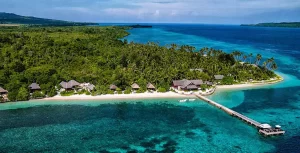Essential Information
- Location: Southeast Sulawesi, Indonesia
- Size: 1.39 million hectares, covering the Wakatobi archipelago
- Climate: Tropical, with warm temperatures year-round (27-32°C)
- Best Time to Visit: April to November (dry season, best for diving and snorkeling)
- Famous For: World-class diving, pristine coral reefs, marine biodiversity, and cultural heritage of the Bajo sea gypsies
- Entry Requirements: International travelers may need a visa, and a diving permit is required for some locations.
Interesting Facts
- One of the Most Diverse Coral Reefs in the World – Wakatobi is part of the Coral Triangle, home to 750+ coral species and 942 fish species.
- Named After Four Main Islands – Wangi-Wangi, Kaledupa, Tomia, and Binongko form the park’s name.
- UNESCO Marine Biosphere Reserve – Recognized for its ecological significance and conservation efforts.
- Home to the Bajo Sea Nomads – The Bajo people, also called “sea gypsies,” live in stilt houses over the water.
- One of the World’s Best Diving Spots – Known for its crystal-clear waters, spectacular walls, and unique marine species like pygmy seahorses and manta rays.
How to Get There
- Fly to Matahora Airport (WNI) on Wangi-Wangi Island
- Boat Transfers to Other Islands
- Ferries and speedboats connect Wangi-Wangi to Kaledupa, Tomia, and Binongko.
- Private speedboats are available for faster transfers.
Best Things to Do in Wakatobi National Park
- Diving and Snorkeling in the Coral Triangle
- Explore famous dive sites like Roma, Table Coral City, and House Reef.
- Encounter sea turtles, reef sharks, barracudas, and vibrant coral gardens.
- Meet the Bajo People at Sama Bahari Village
- Visit floating villages, learn about the sea nomad lifestyle, and experience traditional handline fishing.
- Relax on the White Sand Beaches of Hoga Island
- Enjoy crystal-clear waters, coral reefs, and peaceful surroundings.
- A paradise for snorkeling and beach lovers.
- Explore Tomia Island’s Scenic Hills and Sunset Viewpoints
- Hike up Puncak Kahyangan (Heaven’s Peak) for stunning ocean views.
- Visit Lakota Beach for sunset photography.
- Kayaking and Paddleboarding in Mangrove Forests
- Discover the rich ecosystem of Kaledupa’s mangrove forests.
- Spot exotic birds, crabs, and other wildlife.
- Trek to Binongko Island – The Land of Blacksmiths
- Watch traditional iron-forging techniques, a centuries-old heritage.
- Visit secluded beaches and untouched reefs.
- Underwater Photography and Freediving
- Capture the vibrant macro marine life.
- Popular sites: Roma, Cornucopia, and Blade reefs.
Best Accommodation Options
- Wakatobi Dive Resort (Luxury, Wangi-Wangi)
- A world-class eco-resort with private villas and exclusive dive experiences.
- Hoga Island Dive Resort (Mid-Range, Hoga Island)
- Perfect for budget travelers and dive enthusiasts, offering basic beach bungalows.
- Patuno Resort Wakatobi (Mid-Range, Wangi-Wangi)
- A beachfront resort with diving packages and boat tours.
- Homestays in Kaledupa & Tomia (Budget-Friendly)
- Stay with locals in traditional stilt houses over the water.
Top Attractions in Wakatobi National Park
- Roma Reef – One of the Most Colorful Dive Sites
- Table Coral City – A Stunning Underwater Landscape
- Bajo Village (Sama Bahari) – The Floating Sea Nomad Community
- Hoga Island – A Tropical Paradise for Snorkeling & Diving
- Puncak Kahyangan – The Best Sunset Spot in Wakatobi
Getting Around
- By Boat: Inter-island travel via ferries, speedboats, or private charters.
- By Motorbike or Bicycle: Rentable on Wangi-Wangi, Kaledupa, and Tomia.
- By Local Ojek (Motorcycle Taxi): Common for short-distance travel on the islands.
Day Trips & Nearby Adventures
- Kapota Island (Hidden Beaches & Snorkeling)
- A quiet escape with secluded beaches and shallow coral reefs.
- Anano Beach (Turtle Conservation Site)
- Witness baby turtles hatching and making their way to the ocean.
- Binongko Island’s Traditional Blacksmith Village
- See centuries-old iron-smithing techniques used to make traditional knives and machetes.
Practical Tips
Book Flights & Accommodation Early: Limited transport and resorts available, especially during peak season.
Respect Marine Life: No touching corals, no feeding fish, and use reef-safe sunscreen.
Bring Enough Cash: ATMs are only available in Wangi-Wangi, and most places operate on cash.
Check Diving Certification: Some sites require advanced diving certification.
Wear Light & Breathable Clothing: It’s hot and humid year-round.
Prepare for Limited Internet Access: Wi-Fi is available in major resorts, but remote islands have weak signals.
Conclusion
Wakatobi National Park is a hidden gem for divers, snorkelers, and adventure seekers, offering stunning coral reefs, marine biodiversity, and rich cultural experiences. Whether you’re diving in the Coral Triangle, meeting the Bajo sea nomads, or enjoying pristine beaches, Wakatobi is a true paradise in Indonesia.

